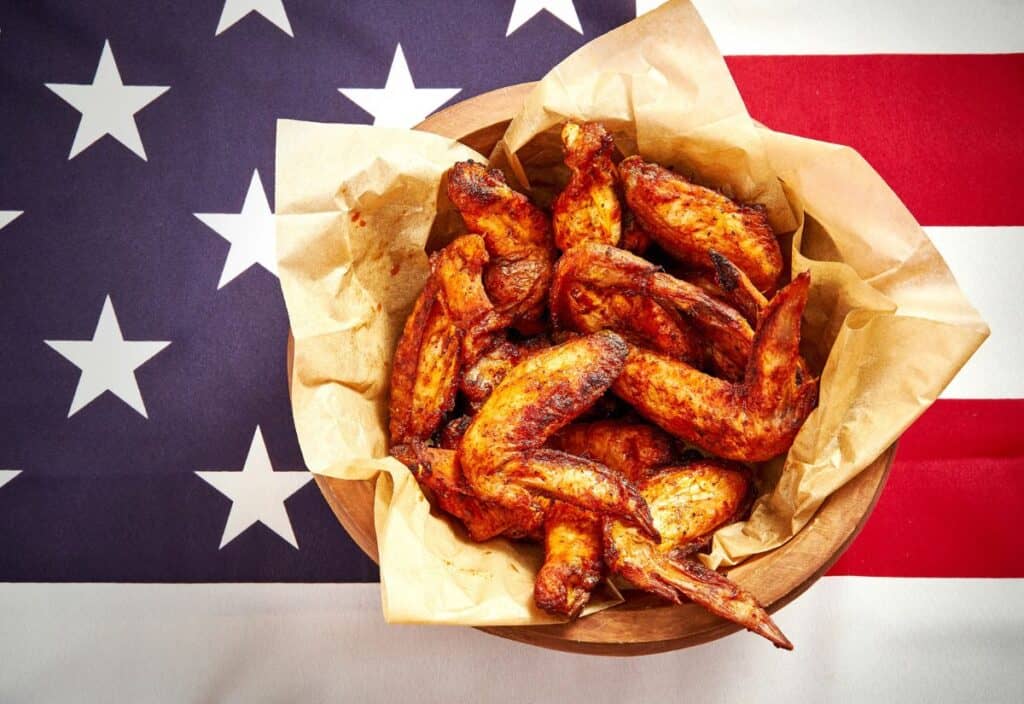Chicken wings are a common finger food at restaurants, bars, sports kickbacks and parties. But they weren’t always the favorite appetizer they are today. Initially made as a quick snack, chicken wings have had a surprising rise to become America’s most popular finger food.

Traditional chicken wings are deep-fried and coated with buffalo sauce, a mixture of hot sauce and butter. Bleu cheese dressing and celery contrast with the vinegary heat of the buffalo sauce.
Although chicken wings are popular all year round, they have long been the snack of choice for sports games. In 2024, the National Chicken Council estimated Americans would eat 1.45 billion wings during the Superbowl alone. To honor the billions of wings eaten each year and the history of this quintessential American food, the city of Buffalo, NY, leads the celebration of National Chicken Wing Day on July 29.
While the traditional buffalo wing is a finger food staple, chicken wings have evolved over the decades. Boneless chicken wings deliver popular flavors without the hassle of eating around bones. New flavors and even vegetarian options have only expanded the popularity of wings, making them a must have when you crave finger foods.
Invention of buffalo chicken wings in Buffalo, NY
Before the 1960s, chicken wings were a cheap cut of meat that only rarely featured on restaurant menus. The Buffalo History Museum records a menu from the Clarendon Hotel in 1857 that offers fried chicken wings. In the American South, fried chicken was a traditional dish at events and Sunday luncheons. Otherwise, chicken wings were largely recycled into broth.
This began to change in 1961, when John Young opened Wings ‘N Things in Buffalo, according to Buffalo Bike Tours. Originally from Alabama, Young sold whole wings, battered and deep fried. Diners would dip their wings in mumbo sauce, a tomato-based sauce similar to BBQ.
Across town at the Anchor Bar, owner Teressa Bellissimo needed a quick snack for her son Dominic and his friends one evening in 1964. She quickly deep fried chicken wings and added Frank’s Red Hot and butter. The wings were such a hit that she added them to the bar menu the next morning as buffalo wings, serving them with celery sticks and bleu cheese dressing.
How the chicken wing became a national snack
With the immediate success of buffalo wings at the Anchor Bar, Bellissimo’s son and the bar’s hot sauce vendor, Dick Winger, traveled around the country. They promoted the wing recipe and Winger’s hot sauce to restaurants.
Wings were a cost-effective option for restaurants, leftover after chickens were portioned into breast and thigh meat for sale. Since spicy and salty wings pair well with many types of beer, restaurants also saw their beer sales skyrocket with wings on the menu.
Some restaurants caught onto the idea, but it was when McDonald’s added wings to their menu that they became a national staple. According to the National Chicken Council, Mighty Wings appeared on McDonald’s menu in 1990. KFC added Hot Wings to their menu in 1991 and Domino’s debuted wings in 1994.
The emergence of chicken wings coincided with the rise in televised sports. Sports bars began installing TVs. When patrons gathered to watch that evening’s game, wings served as an affordable and shareable snack for the table. Today, football and buffalo wings are a perfect match.
Serving up chicken wings today
Chicken wings have come a long way since their humble origins as ingredients for chicken broth. They’ve evolved even beyond the dish Teressa Bellissimo first served at the Anchor Bar. New flavors, inspiration drawn from other cultures and alternatives to traditional wings offer dozens of options. Today, there are chicken wings for every taste and every event.
Beyond buffalo sauce: New chicken wing flavors
Although buffalo remains the most popular wing flavor according to Wing Addicts, diners have hundreds of options. BBQ, teriyaki, lemon pepper, cajun, garlic parmesan, sweet chili and mango-habanero are top choices. Many of these flavors are also available as either a sauce or a dry rub.
Cultural influences and experimentation have introduced new sauce flavors as well. Korean BBQ, Nashville hot, sriracha, fish sauce and even peanut butter and jelly wings offer endless options.
Bleu cheese dip was the original wing dip. Today, ranch is another popular option, especially if you make homemade ranch dressing for homemade wings. Honey mustard, hot honey and BBQ sauce are also good options.
Homemade chicken wings and healthy alternatives
Making your own chicken wings is a great way to customize flavors and spice levels. You can deep fry wings yourself or cook wings in an air fryer for an oil-free alternative. Baked chicken wings are a tasty homemade option that is healthier and lower mess than frying.
Whether you make your own wings or order them to go, you can always make sides to accompany chicken wings. Celery sticks, carrot sticks and other raw veggies are standards. Making a lettuce salad is a healthy option that has the same cool contrast to spicy wings.
Meat-less chicken wings for plant-based diets
With growing interest in plant-based eating, several companies have introduced vegetarian alternatives to chicken wings. Cauliflower wings covered with buffalo sauce have a similar flavor and texture to chicken, making them a common vegetarian alternative. Soy-based, seitan and mushroom are other alternatives for both homemade and store-bought wings.
Chicken wings: From innovative snack to party favorite
Whether as a snack, an appetizer or the main meal, chicken wings are one of America’s most popular finger foods. However you enjoy your wings — fried or baked, with tangy buffalo sauce or more experimental flavors, homemade or from your favorite restaurant — celebrate National Chicken Wing Day on July 29 with this historic food.
Sharon Rhodes is the creative force behind the food blog The Honour System. Passionate about all things homemade, Sharon is a seasoned recipe curator focused on making healthier cooking and baking accessible to all.